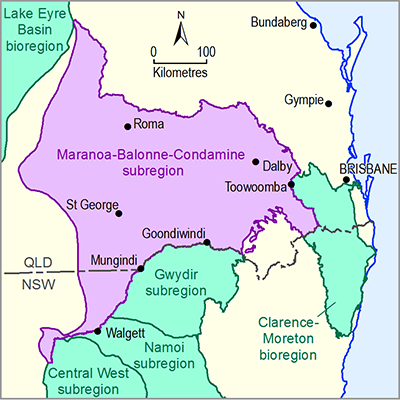- Home
- Assessments
- Bioregional Assessment Program
- Maranoa-Balonne-Condamine subregion
- 5 Outcome synthesis for the Maranoa-Balonne-Condamine subregion
Executive summary

About the subregion
This synthesis presents the key findings from the bioregional assessment of the Maranoa-Balonne-Condamine subregion, part of the Northern Inland Catchments bioregion.
The Maranoa-Balonne-Condamine subregion covers 144,890 square kilometres (km2) of the Murray–Darling Basin in Queensland and NSW. Land is predominantly used for agriculture, with groundwater used for stock and domestic purposes, town water supply and irrigated agriculture. The subregion contains seasonal, semi-permanent and permanent wetlands and lagoons, including some nationally significant wetlands.
Open-cut coal mines in the subregion access the relatively shallow Walloon Coal Measures of the Surat and Clarence-Moreton geological basins in the east. Coal seam gas (CSG) is extracted from the deeper resources of the Walloon Coal Measures between Roma and Millmerran. The groundwater model encompasses the 129,956 km2 assessment extent.
Potential hydrological changes
Queensland’s Office of Groundwater Impact Assessment (OGIA) groundwater model was adapted for this assessment to predict the potential cumulative impacts of existing (baseline) and proposed (additional) coal resource development. Surface water modelling was not carried out for this assessment.
Hydrological modelling identified changes in groundwater for two futures. The baseline future includes five open-cut coal mines and five CSG fields. The coal resource development pathway (CRDP) future includes baseline coal resource developments and two additional coal resource developments that are open-cut coal mines: New Acland Coal Mine Stage 3 south-east of Dalby, which is an expansion of the baseline New Acland Coal Mine, and The Range coal mine between Taroom and Chinchilla. The difference between groundwater drawdown under these two futures is due to the additional coal resource developments.
Near the proposed New Acland Coal Mine Stage 3, predicted drawdown in the regional watertable (which represents the upper groundwater level within the near-surface aquifer) is related to the existing and proposed New Acland Coal Mine operations. Drawdown predicted near The Range coal mine is due to the cumulative impact of the proposed mine and existing CSG development, and may require further assessment of potential cumulative impacts at a local scale.
To rule out potential impacts to water-dependent landscapes and assets, such as wetlands or bores, the impact and risk analysis used a threshold of at least a 5% chance of greater than 0.2 metres (m) drawdown due to additional coal resource development. This conservative threshold matches state regulations. Drawdown due to additional coal resource development exceeds this threshold in an area of 1544 km2 (1.2% of the total area investigated, known as the assessment extent). This includes 1095 km of streams (1.8% of all streams in the assessment extent).
Potential impacts
Potential impacts due to additional coal resource development are very unlikely (less than 5% chance) for:
- the source aquifer of any of the 177 springs in the assessment extent
- the source aquifer of 9827 of the 9990 groundwater bores (economic assets) in the assessment extent.
Additional coal resource development might affect:
- 41 ecosystems, including regional ecosystems and the potential habitats of threatened species and ecological communities
- 163 bores that are contained in 7 water access rights and 6 basic water rights (stock and domestic)
- one of the 135 sociocultural assets in the assessment extent, the Barakula State Forest, near Miles in Queensland.
Due to the conservative nature of the modelling, the greatest confidence in results is for those areas that are very unlikely to be impacted. Where potential impacts have been identified, further work is required to determine the presence and magnitude of impacts to assets. Integrating the groundwater model with a surface water model would provide further information about impacts on surface water.

- Explore this assessment
- About the subregion
- How could coal resource development result in hydrological changes?
- What are the potential hydrological changes?
- What are the potential impacts of additional coal resource development on the landscape?
- What are the potential impacts of additional coal resource development on water-dependent assets?
- How to use this assessment
- Building on this assessment
- References and further reading
- Datasets
- Contributors to the Technical Programme
- Acknowledgements
- Citation
